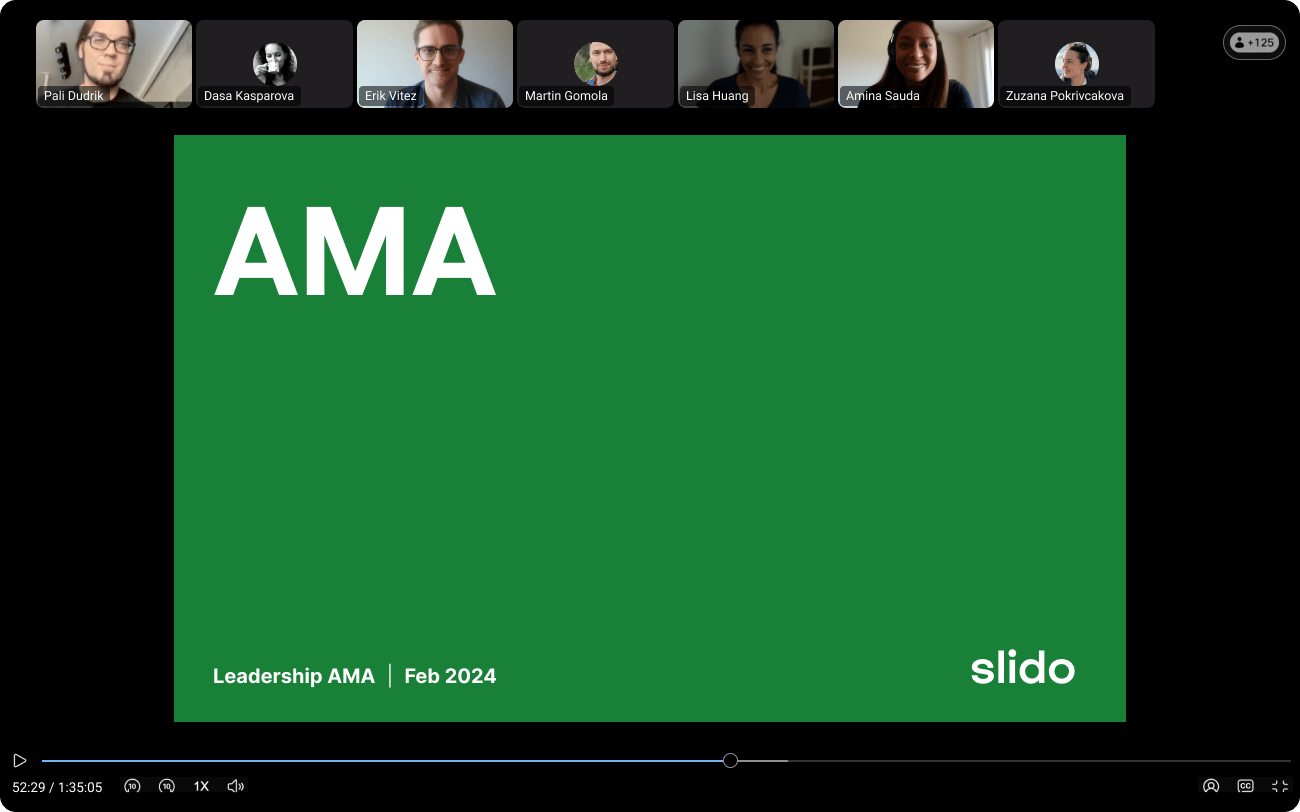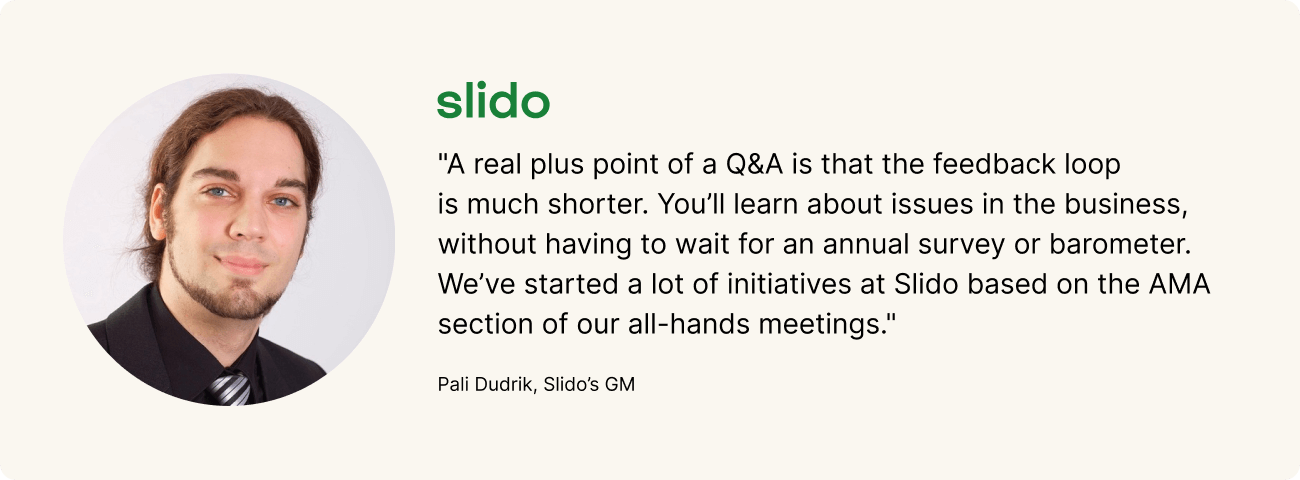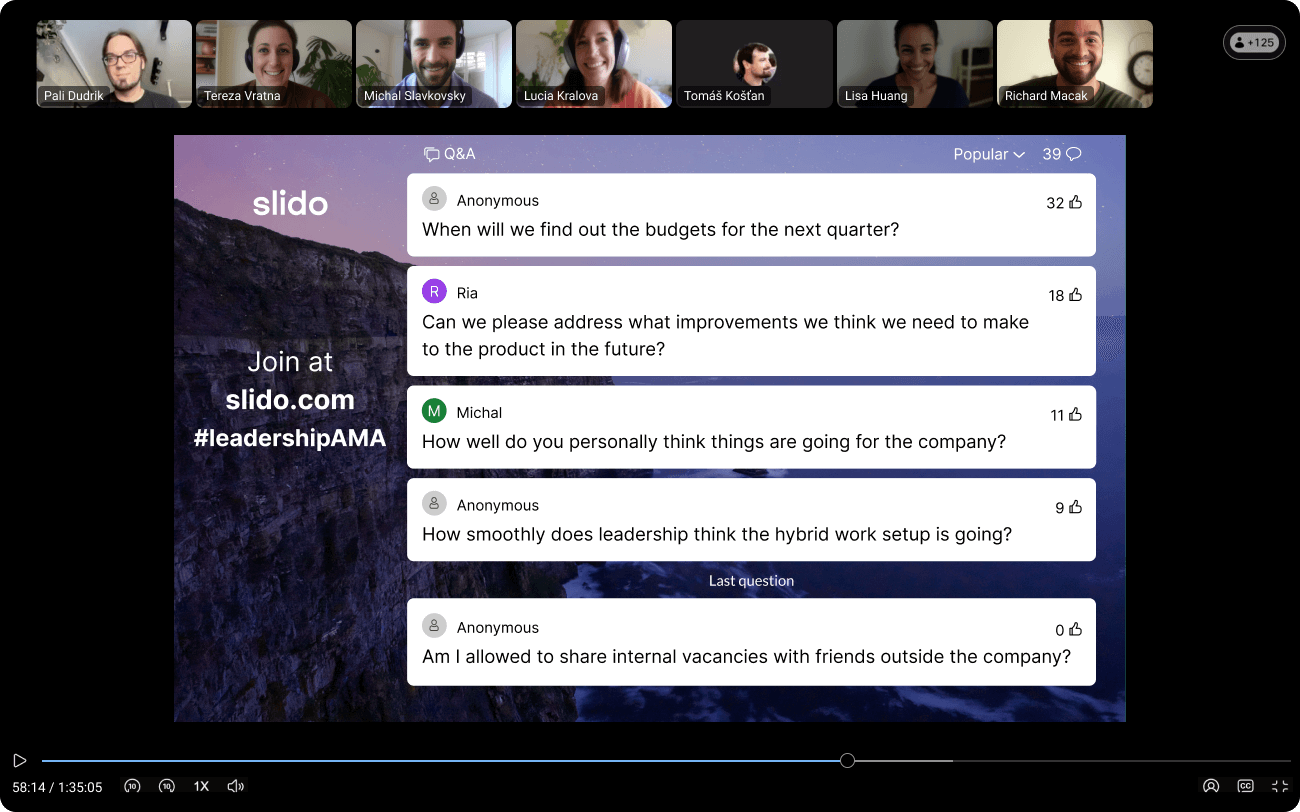An Ask Me Anything (AMA) session is an opportunity for your team to ask questions and feel heard. It gives them the chance to get answers and feel valued.
But holding a Q&A isn’t always the easiest option. Feeling put on the spot by tough questions can be nerve-wracking – which is why some leaders may shy away from it.
However, if you can give people within your organization the chance to have this kind of two-way conversation with you, it will lead to deeper levels of trust and transparency in the long term.
And with increased trust, comes happier and more productive teams.
A study by the Harvard Business Review shows that employees at high-trust companies are 50% more productive, 75% more engaged and 106% more energized than people working at low-trust companies.
In this blog, we will explore why holding leadership AMA sessions can help your organization and enhance company culture.
We’ll also give some insider tips on how Slido’s leaders handle AMAs, as well as how we prepare and facilitate AMA sessions here at Slido.
We’ll cover:
- What does AMA mean?
- Why should leaders run an AMA?
- How do AMAs help to build trust?
- How leaders can prepare themselves for Ask Me Anything questions
- What to do if you don’t have all the answers during an AMA
- How we facilitate an AMA session at Slido
What does AMA mean?
If you’ve seen an Ask Me Anything session happening on social media, it’s just that: an allocated time where people can ask their favorite creators any questions that are on their mind.
But an AMA isn’t just for the public to ask influencers and celebrities questions on Instagram or TikTok – it’s also a powerful and versatile leadership tool, and one that can and should be used in the workplace.
You might want to hold an Ask Me Anything session for a specific event, such as a team restructure, when employees will have lots they want to ask about.

An AMA might become a regular event. At Slido, we have a monthly open questions section during our all-hands.
Why should leaders run an AMA?
An AMA session gives employees the opportunity to interact with senior leaders.
In a hybrid company, AMAs can help employees feel connected even when they are not in the office together every day. This is important for maintaining a sense of unity.
That’s why it’s crucial to make sure that distributed team members are able to contribute, whatever time zone they’re in, by asking staff to submit questions in advance via a Q&A tool like Slido (read more about that in our tips section).

During uncertain times, an AMA is a good opportunity for leaders to address any rumors or gossip head-on.
It’s OK to feel nervous. Remember that revealing vulnerability will show you as a human and can help employees understand and connect with you better.
Read more: There’s a Reason Leaders Fear the Q&A… But They Should Do It Anyway
How do AMAs help to build trust?

Many leaders use surveys to gather feedback from employees. And while a survey has its place, it’s more “static” and doesn’t have the same impact that a live and interactive leadership Ask Me Anything session does.
Our latest research actually shows that leaders who use live Q&A tools are actually perceived as more caring and approachable than those solely relying on surveys. You can read more about this in our new ebook, Great Meetings, Great Cultures.
When hosting an AMA, you can have an open conversation with your team to understand their thoughts. The conversation allows for two-way communication in real-time.
Pali Dudrik, Slido’s GM says, “A real plus point of a Q&A is that the feedback loop is much shorter. You’ll learn about issues in the business, without having to wait for an annual survey or barometer. We’ve started a lot of initiatives at Slido based on the AMA section of our all-hands meetings.”
Employees will feel psychological safety if they’re able to ask questions anonymously.
While anonymous questions may understandably feel challenging to a leader, they will also shine a spotlight on issues that need to be addressed.
By speaking about these burning issues directly, your team will see you as a more authentic and human leader.

You can always moderate an AMA, which will help with quality control. But remember that the more censored your session is, the less chance you’ll get to build trust with your employees.
If you’re feeling nervous, remember that the more you run AMA sessions, the more confident you’ll feel with them.
When staff feel like their voices are being heard, trust will be nurtured and will grow. A culture where people are encouraged to speak up – rather than fearing to – will be encouraged.
How leaders can prepare themselves for Ask Me Anything questions
An AMA is “a learning experience,” says Pali. “It’s about committing to transparency and empowering employees to be open about topics that are important to them, creating a safe space.”
The key is preparation, and leaders will have the chance to think about what they’re going to say when they collect questions prior to the meeting with Slido.
“We open our AMA questions four days before the all-hands,” says Pali. “During those four days I monitor the questions, and we do a dry run. I go through the questions in advance and write answers.”
While difficult questions can be daunting, Pali says that avoiding doing Q&As creates a type of company culture in itself. “People will fill in the blanks themselves, which is when rumors and assumptions can start.”
He believes that harshly-worded questions still have a value. “I wouldn’t fail to acknowledge the question itself and the concern behind it,” he says. “I try to walk in the shoes of the person asking the question, and use this question as a learning opportunity.”
What to do if you don’t have all the answers during an AMA
It’s about being as genuine as possible with your responses, and if you don’t know the answer, commit to finding out after the AMA has finished.
“Back in 2021, Slido was acquired by Cisco and we ran Q&A sessions around it,” says Kati Gabova, Head of People at Slido.
“At that time, there were hundreds of good questions from people. We didn’t have most of the answers, but we felt that it was the time to give people the space to ask those questions and share their concerns.”
Kati says that although a lot of the information employees wanted wasn’t available, “being there in front of the people” was key during a period of great change.
“It helped us to keep a close connection to our team,” she says.
You can further build trust by committing to follow up on any unanswered questions after the meeting.
These responses can be shared via email, on Slack or your company’s intranet. Staff will appreciate a leader who acts on their word and makes sure that all questions are addressed.
Read more: What to Do With Unanswered Questions After Your All-Hands Meeting
How we facilitate an AMA session at Slido
Sabine Brossart is a Customer Education Manager at Slido, and often acts as a moderator at all-hands meetings. Here are her tips for running an AMA from a moderator’s perspective.
Open the questions in advance
“We consciously choose to open the Q&A in advance using Slido to maximize participation,” Sabine says.
“Our team is dispersed across the whole globe and not everyone will be able to attend an AMA session live. But that should never exclude them from asking their questions and having their voices heard.”
There’s another advantage to opening questions before the meeting. “As a moderator, I can watch the incoming questions from the beginning and prepare the speakers accordingly. We get a feeling of what may come and which may be the most pressing topics.”
Make sure to monitor questions during the AMA
Sabine says, “During the live session I monitor the incoming questions regularly. We always allow anonymous questions, and do not use the moderation feature, so every question that gets posted is immediately live.
“If a question is inappropriate and should be addressed, I’ll add a moderator’s reply to it through Slido.”
If Sabine receives a tough question, she usually “reformulates” it when reading it out loud. “I will soften the tone but still maintain the core message, to be true to the person who posted it.”
How to structure and group questions for leaders to answer
“In Slido, we rely on upvotes to find the ‘hot topics,” Sabine explains. “By upvoting, the audience picks their favorite questions. This helps me find a good opening question and make a structure. We remind everyone several times to upvote the questions which are the most relevant to them.”

To create a structure to the AMA, Sabine recommends grouping together blocks of similar questions and asking them in one go.
“What I usually do is open the Q&A with the most upvoted question and create a block of around three questions if there are more on the same topic.
“Moving on, I like to mix the most upvoted questions with relevance – if a topic has a reasonable amount of likes and is more relevant to the current circumstances, I may prioritize it over popular questions with less relevance.”
To stay organized, Sabine recommends labeling the questions in Slido. “Labels help you keep an overview of the questions and allow you to filter them, which makes it very easy to create and later on find the groups of questions. We label questions by theme, or by speaker name.”
Final thoughts…
Building trust within your organization takes time, but making the time to run an AMA will pay dividends in the long run.
Your team will feel more connected to leadership, and you’ll be able to show yourself as not just a leader, but an authentic human being who values their questions.
Slido is here to help you in your journey – just reach out below and we’ll help you organize a smooth AMA session.




